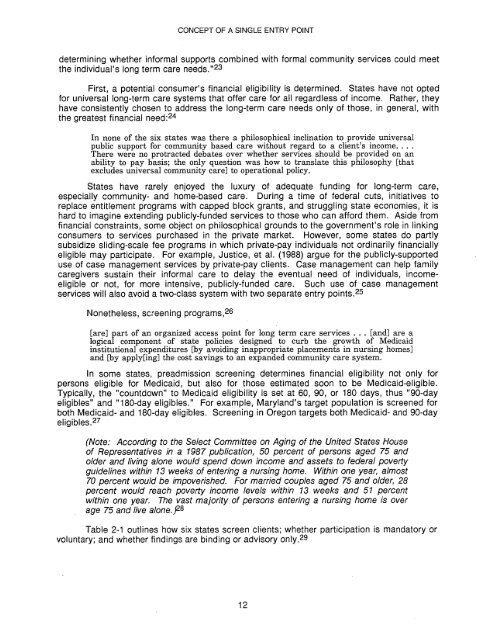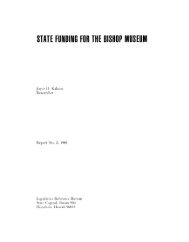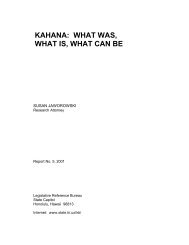long-term care - Legislative Reference Bureau
long-term care - Legislative Reference Bureau
long-term care - Legislative Reference Bureau
Create successful ePaper yourself
Turn your PDF publications into a flip-book with our unique Google optimized e-Paper software.
CONCEPT OF A SINGLE ENTRY POINT<br />
de<strong>term</strong>ining whether informal supports combined with formal community services could meet<br />
the individual's <strong>long</strong> <strong>term</strong> <strong>care</strong> needs. "23<br />
First, a potential consumer's financial eligibility is de<strong>term</strong>ined. States have not opted<br />
for universal <strong>long</strong>-<strong>term</strong> <strong>care</strong> systems that offer <strong>care</strong> for all regardless of income. Rather, they<br />
have consistently chosen to address the <strong>long</strong>-<strong>term</strong> <strong>care</strong> needs only of those, in general, with<br />
the greatest financial need: 24<br />
In none of the six states was there a philosophical inclination to provide universal<br />
public support for community based <strong>care</strong> without regard to a client's income ....<br />
There were no protracted debates over whether services should be provided on an<br />
ability to pay basis; the only question was how to translate this philosophy [that<br />
excludes universal community <strong>care</strong>] to operational policy.<br />
States have rarely enjoyed the luxury of adequate funding for <strong>long</strong>-<strong>term</strong> <strong>care</strong>,<br />
especially community- and home-based <strong>care</strong>. During a time of federal cuts, initiatives to<br />
replace entitlement programs with capped block grants, and struggling state economies, it is<br />
hard to imagine extending publicly-funded services to those who can afford them. Aside from<br />
financial constraints, some object on philosophical grounds to the government's role in linking<br />
consumers to services purchased in the private market. However, some states do partly<br />
subsidize sliding-scale fee programs in which private-pay individuals not ordinarily financially<br />
eligible may participate. For example, Justice, et al. (1988) argue for the publicly-supported<br />
use of case management services by private-pay clients. Case management can help family<br />
<strong>care</strong>givers sustain their informal <strong>care</strong> to delay the eventual need of individuals, incomeeligible<br />
or not, for more intensive, publicly-funded <strong>care</strong>. Such use of case management<br />
services will also avoid a two-class system with two separate entry points. 25<br />
Nonetheless, screening programs,26<br />
[are] part of an organized access point for <strong>long</strong> <strong>term</strong> <strong>care</strong> services ... [and] are a<br />
logical component of state policies designed to curb the growth of Medicaid<br />
institutional expenditures [by avoiding inappropriate placements in nursing homes]<br />
and [by apply[ing] the cost savings to an expanded community <strong>care</strong> system.<br />
In some states, preadmission screening de<strong>term</strong>ines financial eligibility not only for<br />
persons eligible for Medicaid, but also for those estimated .soon to be Medicaid-eligible.<br />
Typically, the "countdown" to Medicaid eligibility is set at 60, 90, or 180 days, thus "90-day<br />
eligibles" and "180-day eligibles." For example, Maryland's target population is screened for<br />
both Medicaid- and 180-day eligibles. Screening in Oregon targets both Medicaid- and 90-day<br />
eligibles. 27<br />
(Note: According to the Select Committee on Aging of the United States House<br />
of Representatives in a 1987 publication, 50 percent of persons aged 75 and<br />
older and living alone would spend down income and assets to federal poverty<br />
guidelines within 13 weeks of entering a nursing home. Within one year, almost<br />
70 percent would be impoverished. For married couples aged 75 and older, 28<br />
percent would reach poverty income levels within 13 weeks and 51 percent<br />
within one year. The vast majority of persons entering a nursing home is over<br />
age 75 and live alone. f28<br />
Table 2-1 outlines how six states screen clients; whether participation is mandatory or<br />
voluntary; and whether findings are binding or advisory only.29<br />
12
















